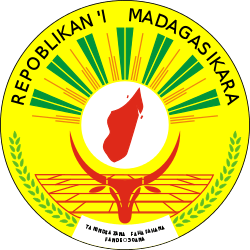India–Madagascar relations
India–Madagascar relations refers to the current and historical relationship between India and Madagascar.
 | |
India |
Madagascar |
|---|---|
History
Relations between Madagascar and western India began in the 18th century and regular trade dates to at least the late 19th century. Interstate relations began in 1954 when independent India established a consulate in French-controlled Madagascar. When Madagascar became independent in 1960, the consulate was upgraded to embassy status.
In February 2011, relations were considered cordial, with several high-level officials having had exchanging visits over the course of relations. Approximately 20,000 people of Indian origin lived in Madagascar, including 2,500 Indian citizens.[1]
In March 2018, Ram Nath Kovind became the first Indian President to visit Madagascar. Kovind was conferred the Grand Cross of the Second Class, Madagascar's highest honour for non-citizens, by Prime Minister of Madagascar Olivier Solonandrasan.[2]
On 28 January 2020, the Indian Navy has launched ‘Operation Vanilla' to help flood-hit Madagascar. Indian Navy's Airavat has been reached at Madagascar on January 30. Indian Navy's large amphibious ship will provide all necessary assistance to disaster-hit Madagascar. Indian Ambassador to Madagascar Abhay Kumar on Friday handed over the relief material to country's Prime Minister Christian Ntsay as part of New Delhi's efforts to support the people of the flood-hit African country. The relief material, which includes food items, clothing, and other essential consumer goods, had arrived at the port of Antsiranana on Indian Naval Ship Airavat Ntsay accepted the relief material from the Indian Ambassador in the presence of Commander Sunil Sankar, officers and men of INS Airvat at a brief function held at Antsiranana Port. Indian Naval Ship Airvat carrying the relief material had been diverted to Madagascar after the country was ravaged by torrential rains and floods. The relief materials include rice, lentils, tea, cooking oil, flour, instant food, chocolate, milk powder, cheese, biscuits, jam, clothing, tarpaulin, tents, bed-spreads, blankets, shoes, essential consumer goods, disinfectants, flash lights, personnel protective equipment etc. In addition to the above, it also includes medicines to treat the diseases which might occur in the aftermath of floods. The medicines shall cater to a large number of patients. Speaking on the occasion, Kumar said that India stands with Madagascar in this hour of need. "We are two neighbours connected by the ocean. Our quick action to divert INS Airvat to support flood relief operations in Madagascar speaks louder than our words. India has always stood with its neighbours, whether land or maritime and will always continue to do so. We are often the first country to extend help whenever a neighbour faces a natural disaster. Speaking in turn, Ntsay expressed his deep gratitude for the aid and remarked, "This moment is witness to excellent relations between India and Madagascar, it is a historic relationship and we are very proud of witnessing today this solidarity, generosity and brotherhood between the two countries." The ceremony was attended by senior civil and military dignitaries in addition to the Prime Minister and his delegation.
Trade and finance
In November 2008, Exim Bank gave Madagascar a $25 million loan for agricultural improvements. As of 2011, 61 Malagasy people had received training as part of the Indian Technical and Economic Cooperation Programme.[1] In March 2018, to facilitate its financial assistance programme, India decided to offer Madagascar a US$80.7 million Line of Credit (LoC) for agriculture and mechanisation.[3]
Military
India Navy operates a Coastal Surveillance Radar (CSR) station in Madagascar.[4]
Geological history
In 2013, scientists discovered that Madagascar and India were part of a single continent about 85 million years ago. The sliver of land joining them is called Mauritia. Madagascar was connected to the south-western part of India. It shares vegetation and both have dense evergreen forests.[5]
References
- REPUBLIC OF MADAGASCAR: COUNTRY BRIEF and BILATERAL RELATIONS
- "Ram Nath Kovind becomes first Indian president to visit Madagascar; will interact with businessmen, students today". Firstpost. 15 March 2018. Retrieved 21 July 2018.
- "Press Release on State Visit of President to Madagascar (March 14-15, 2018)". Ministry of External Affairs, Government of India. 15 March 2018. Retrieved 21 July 2018.
- "India activates first listening post on foreign soil: radars in Madagascar - Indian Express".
- "Mauritia, a lost continent found off coast of Madagascar | National Post". 26 February 2013.

